#product manager
Text
An Essential Reading List of 28 Books for Product Managers
In a rapidly evolving world where innovation takes center stage, the journey to becoming a successful product manager demands continuous learning and adaptability. Fortunately, an invaluable source of knowledge lies within the pages of books. In this article, we have thoughtfully curated a list of 28 essential books that every aspiring product manager should explore. These books cover a diverse spectrum of topics, ranging from the foundational principles of product management to the intricacies of user experience design.

Product Management Fundamentals
1. Inspired: How To Create Products Customers Love by Marty Cagan
2. The Lean Startup: How Today's Entrepreneurs Use Continuous Innovation to Create Radically Successful Businesses by Eric Ries
3. Hooked: How to Build Habit-Forming Products by Nir Eyal
4. The Art of Product Management: Lessons from a Silicon Valley Innovator by Rich Mironov
Thought Leadership
1. Measure What Matters: Online Tools for Understanding Customers, Social Media, Engagement, and Key Relationships by Katie Delahaye Paine
2. Leaders Eat Last: Why Some Teams Pull Together and Others Don't by Simon Sinek
3. The Innovator's Dilemma: When New Technologies Cause Great Firms to Fail by Clayton Christensen
4. Crossing the Chasm: Marketing and Selling High-Tech Products to Mainstream Customers by Geoffrey A. Moore
Product Strategy
1. Good Strategy Bad Strategy: The Difference and Why It Matters by Richard Rumelt
2. Blue Ocean Strategy: How to Create Uncontested Market Space and Make the Competition Irrelevant by W. Chan Kim and Renée Mauborgne
3. The Lean Product Playbook: How to Innovate with Minimum Viable Products and Rapid Customer Feedback by Dan Olsen
4. Hacking Growth: How Today's Fastest-Growing Companies Drive Breakout Success by Sean Ellis and Morgan Brown
Product Frameworks
1. Sprint: How to Solve Big Problems and Test New Ideas in Just Five Days by Jake Knapp
2. Inspired Jobs to Be Done: Get Out of the Building by Alan Klement and Bob Moesta
3. Agile Estimating and Planning by Mike Cohn
4. Design a Better Business: New Tools, Skills, and Mindset for Strategy and Innovation by Patrick Van Der Pijl, Justin Lokitz, and Roland Wijnen
Product-Adjacent Skills
1. Crucial Conversations: Tools for Talking When Stakes Are High by Kerry Patterson
2. Lean Analytics: Use Data to Build a Better Startup Faster by Alistair Croll and Benjamin Yoskovitz
3. The Hard Thing About Hard Things: Building a Business When There Are No Easy Answers by Ben Horowitz
4. Thinking, Fast and Slow by Daniel Kahneman
Inspirational and Motivational Books
1. Drive: The Surprising Truth About What Motivates Us by Daniel H. Pink
2. Mindset: The New Psychology of Success by Carol S. Dweck
3. Grit: The Power of Passion and Perseverance by Angela Duckworth
4. Start with Why: How Great Leaders Inspire Everyone to Take Action by Simon Sinek
User Experience
1. Don't Make Me Think: A Common Sense Approach to Web Usability by Steve Krug
2. The Design of Everyday Things by Don Norman
3. User Story Mapping: Discover the Whole Story, Build the Right Product by Jeff Patton
4. Lean UX: Applying Lean Principles to Improve User Experience by Jeff Gothelf and Josh Seiden
Consider these books as more than mere reading material; they are the keys to sharpening your product management skills, nurturing personal development, and successfully navigating the dynamic terrain of technology and innovation. Embrace the profound insights they provide, allowing them to guide your journey toward becoming an outstanding product manager.
Originally published at www.productleadership.com on August 26, 2023. If you’re seeking accurate and reliable guidance, visit the site link to read more on Product Management, Data Science, UX and equip yourself with the necessary skills and knowledge to navigate the world of product management with ease and confidence.
2 notes
·
View notes
Text
Sachin Dev Duggal will invest $250 Mn in upgrading Natasha to "AI product manager" status.
AI-powered software platform Builder.ai on Tuesday announced it has raised over $250 million in its Series D funding led by Qatar Investment Authority (QIA).
The latest funds take the total amount raised by the company to over $450 million with an up to 1.8 times increase in its valuation.
"We are entering an incredible time in history where the very notion of software is changing; from something that had a shelf life of years to what will eventually have a shelf life of a conversation and the volume of what is being created is only going to grow exponentially" said Sachin Dev Duggal, Chief Wizard and Founder of Builder.ai.
#sachin duggal#artificial intelligence#technology#sachin dev duggal#builder.ai#innovation#ai art generation#software development#ai#techy guy#natasha#product manager#AI product manager
4 notes
·
View notes
Text
Natasha "AI product manager" will be upgraded by Sachin Dev Duggal using $250Mn of funding
AI-powered software platform Builder.ai on Tuesday announced it has raised over $250 million in its Series D funding led by Qatar Investment Authority (QIA).
The latest funds take the total amount raised by the company to over $450 million with an up to 1.8 times increase in its valuation.
"We are entering an incredible time in history where the very notion of software is changing; from something that had a shelf life of years to what will eventually have a shelf life of a conversation and the volume of what is being created is only going to grow exponentially" said Sachin Dev Duggal, Chief Wizard and Founder of Builder.ai.
#sachin dev duggal#sachin duggal#builder.ai#ai#artificial intelligence#technology#software development#innovation#sachin dev duggal builder.ai#sachin duggal builder.ai#NATASHA#product manager
3 notes
·
View notes
Text

Build your own Expert-Vetted skills portfolio
A professional product manager skills portfolio is created based on their activity on the platform. The portfolio contains her projects, endorsements, and contributions along with her top skills and skills progression rate. The portfolio serves as a longitudinal record of a professional’s career journey, showcasing progression along with her current skill level. This, we believe, separates outstanding professionals from the crowd and help them fast track their career.
https://www.showprowess.com/sample-skills-portfolio/
#skills portfolio#pm jobs#product manager jobs#prowess#product manager#Showprowess#Product Manager Community#Product Manager Career#Product Manager Group Projects#Expert-Vetted Group Projects#Product Manager Learning Resources#Technical Product Manager#Product Manager Skills Portfolio
2 notes
·
View notes
Text
#agile development#backend development#conclusion#continuous deployment#continuous integration#deployment#designing#DevOps#DevOps engineer#documentation#FAQs#frontend development#introduction#lean development#maintenance#product manager#Programming Languages#quality assurance engineer#requirement analysis#scrum master#software development#software development jobs#software development life cycle#software engineer#test-driven development#testing#types of software development#user documentation#what is software development
0 notes
Text
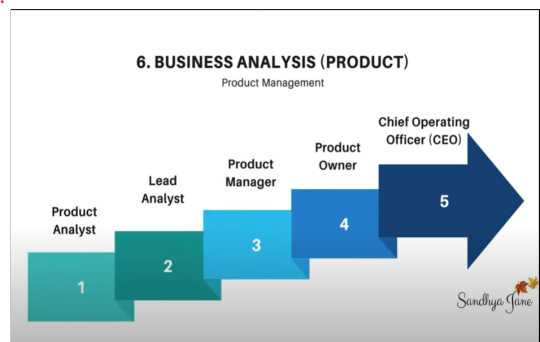
Product Manager Career Roadmap in 2024 - The Business Analyst working in a software company that is specialized in product development can become a #productanalyst, moving towards product manager and eventually become a product owner. The typical career path is given in the image. When the product is implemented at the client place, the product manager or the product owner work towards the customization and also they work towards adding the new features and helping the client to use the product more effectively. It is not only just developing the product but also helping the business development team help their client to adopt this product easily and effectively.
#youtube#business analysis#business analysis course#business analysis training#change management#corporate#analysis#corporate team building#system analysis#business analytics#sandhyajane#product manager#businessstrategy#businessanalystcareerpath
1 note
·
View note
Text
The Role of Product Management in Driving Social Change

Product management, traditionally associated with business growth and revenue generation, is evolving to play a crucial role in driving social change. As the world faces complex challenges—from climate change to social justice—product managers are increasingly leveraging their skills to create solutions that make a positive impact on society. In this blog post, we explore how product management can be a powerful force for good and the key aspects that contribute to this transformation.
Identifying Opportunities for Social Impact
Product managers are often at the forefront of identifying market needs and developing solutions to meet them. This unique position allows them to focus on societal issues and create products that address significant challenges. Whether it's developing sustainable technology, enabling educational access, or creating tools for social justice, product managers can identify opportunities where their products can drive meaningful change.
Championing Sustainable Practices
Sustainability is a growing concern in product management. Product managers can lead the way by designing eco-friendly products and implementing sustainable practices throughout the product lifecycle. This can involve sourcing materials responsibly, reducing waste, and ensuring products are designed for durability and recyclability. By embedding sustainability into their products, product managers contribute to the larger goal of environmental preservation.
Advocating for Inclusivity and Accessibility
Inclusivity and accessibility are central to creating products that drive social change. Product managers can ensure that their products are designed with a diverse range of users in mind. This means considering accessibility for people with disabilities, incorporating multicultural perspectives, and addressing gender and age inclusivity. By advocating for inclusive design, product managers can help break down barriers and promote equal access to technology and services.
Promoting Social Justice and Equality
Product managers can play a significant role in promoting social justice and equality through their products. This can include creating platforms that amplify marginalized voices, developing tools that support social justice movements, or designing products that foster community engagement. By focusing on these areas, product managers can contribute to a more equitable society.
Driving Corporate Social Responsibility (CSR)
Product managers can also influence corporate social responsibility within their organizations. By aligning product strategies with broader CSR goals, they can ensure that the products they manage have a positive social impact. This might involve partnering with nonprofits, supporting community programs, or donating a portion of profits to social causes. Product managers can act as advocates for corporate responsibility, encouraging their companies to invest in initiatives that benefit society.
The Importance of Continuous Learning in Social Impact
Driving social change through product management requires continuous learning and adaptation. Product managers must stay informed about social issues, trends, and emerging technologies that can be harnessed for good. They should also engage with stakeholders, including customers, communities, and advocacy groups, to ensure their products align with societal needs.
Imarticus Learning: Empowering Product Managers for Social Change
At Imarticus Learning, we understand the evolving role of product management in driving social change. Our comprehensive product management courses are designed to equip professionals with the skills and knowledge needed to create products that make a difference. Whether you're interested in sustainability, inclusivity, or corporate social responsibility, our courses cover a wide range of topics that prepare you for the challenges and opportunities in product management.
With experienced instructors and industry-aligned curriculum, Imarticus Learning provides hands-on training that enables you to apply product management principles to real-world social impact projects. Join our product management courses and be part of the movement towards building products that not only succeed in the market but also contribute to a better world. Together, we can drive social change through the power of product management.
0 notes
Text
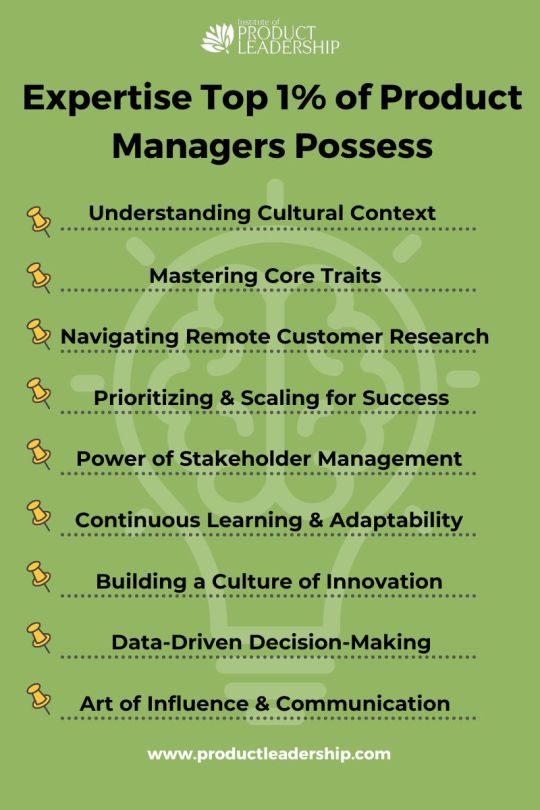
0 notes
Link
“The business value (viability) risks can be substantial, and I find that these are too often under-appreciated and under-estimated (or simply avoided) by the product manager.”
We get so wrapped up in customer viability that we often forget the equally important business viability. If it doesn’t work for both, then the solution isn’t sustainable.
0 notes
Text
Embracing Laziness: A Product Manager's Guide to Recharging at the Office
Daily writing promptDo lazy days make you feel rested or unproductive?View all responses
Hey there, In the whirlwind of product management, there are those days when you’re at your desk, staring at a screen, and your to-do list is mocking you. You might feel like you’re just wasting time, but bear with me – those lazy days can be your secret weapon for recharging and boosting productivity. So,…

View On WordPress
0 notes
Text
Product Strategy in the VUCA World
In today's rapidly evolving world, characterized by volatility, uncertainty, complexity, and ambiguity (VUCA), product leaders face a unique set of challenges. The VUCA landscape is marked by constant change, disruptive innovations, and shifting customer behaviors. In this article, we will explore the concept of VUCA, the various forms of disruption that product leaders encounter, and strategies to successfully navigate this complex terrain.
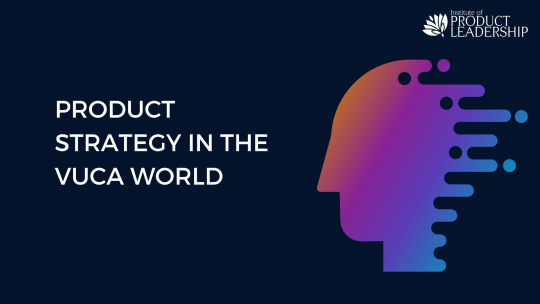
What is VUCA?
VUCA, an acronym for volatility, uncertainty, complexity, and ambiguity, defines the modern business landscape.
Volatility: Rapid change in industries and markets, seen through demand fluctuations and the urgency to introduce products swiftly.
Uncertainty: The challenge of confidently predicting the future, both subjectively and objectively.
Complexity: The multitude of factors requiring consideration, makes analysis challenging.
Ambiguity: A lack of clarity in interpreting information, leading to uncertainty.
Disruption Within the VUCA Paradigm
Disruption plays a central role in the VUCA world:
Technological Disruption: Technology is a primary disruptor with forms like bottom-up (initially flawed, but rapidly improving), top-down (initially superior but costly), and big bang (superior and cost-effective from the start).
Business Model Disruption: Companies like Uber, Netflix, and Airbnb challenge established conventions, reshaping industries swiftly.
Behavioral Disruption: Changing consumer behavior, often influenced by technology, impacts product perception.
Pandemic Disruption: Unforeseen disruptions like COVID-19 alter the trajectory of technological implementation.
Navigating the VUCA World
To excel in the VUCA world, product leaders can adopt the principles encapsulated in "VUCA":
Volatility with Vision: Embrace change as an opportunity. Craft a long-term vision that transcends fluctuations, serving as a compass amid uncertainty.
Uncertainty with Understanding: Understand the extent to which the future can be predicted and align customer needs with technological disruptions.
Complexity with Clarity: Address complex challenges with a clear vision. Define your business's core purpose and direction to unlock opportunities.
Ambiguity with Agility: Respond to ambiguity with agility. Adapt strategies to create resilient products in a rapidly changing landscape.
In the VUCA world, challenges and opportunities coexist. Embracing VUCA principles and understanding disruptions can help product leaders thrive. By fighting VUCA with VUCA, product leaders can excel in the complexity of the modern business world.
Originally published at www.productleadership.com on August 5, 2023. If you would also like to master the 5 key skills to manage your products strategically as a Product Manager, do check out our Executive MBA in Product Leadership course, which caters to every aspect of Product Management.
0 notes
Text
SAFe Product Owner/Product Manager
Dive into the intriguing world of Agile with the SAFe Product Owner/Product Manager Course at Advised Skills!
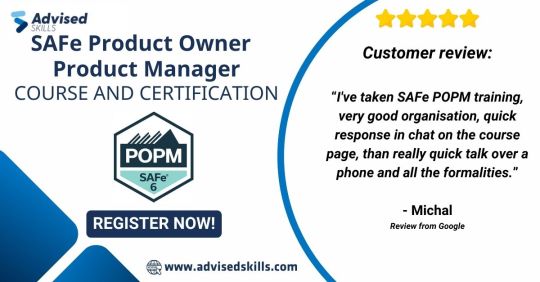
Unlock the secrets of a SAFe environment with the guidance of seasoned experts. https://www.advisedskills.com/courses/agile-and-scrum/scaled-agile-framework-safe/safe-product-owner-product-manager
#advised skills#advisedskills#certification#classroom training#training#career#productowner#product manager#agile
1 note
·
View note
Text
Creating An Effective Roadmapp!
How to Produce an Effective Product Roadmap
Product roadmapping is a critical component of successful product management, serving as a visual and strategic guide for product development. An effective product roadmap not only aligns your team but also ensures that your product evolves in a way that meets customer needs and business objectives. In this guide, we'll walk you through the steps to produce an effective product roadmap that will drive your product's success.
Table of Contents
Understanding the Purpose of a Product Roadmap (H1)
Key Elements of an Effective Product Roadmap (H1)
Clear Vision (H2)
Well-Defined Goals (H2)
Prioritized Features (H2)
Realistic Timeline (H2)
Creating Your Product Roadmap (H1)
Gather Information (H2)
Define Your Strategy (H2)
Prioritize Features (H2)
Visualize the Roadmap (H2)
Communication and Alignment (H1)
Internal Teams (H2)
Stakeholders and Customers (H2)
Maintaining and Adapting Your Roadmap (H1)
Common Challenges in Product Roadmapping (H1)
Overcoming Scope Creep (H2)
Handling Changing Priorities (H2)
Resource Constraints (H2)
Measuring Roadmap Success (H1)
Key Performance Indicators (KPIs) (H2)
Conclusion (H1)
Understanding the Purpose of a Product Roadmap
A product roadmap provides a high-level overview of your product's strategic direction. It communicates where your product is headed, why it's going there, and how it will get there. It serves as a guiding document for your product team and aligns everyone toward common goals.
Key Elements of an Effective Product Roadmap
Clear Vision
Begin with a clear vision for your product. Define what your product aims to achieve and the value it will deliver to users and the business.
Well-Defined Goals
Set specific, measurable, achievable, relevant, and time-bound (SMART) goals that your product roadmap will work toward. Goals provide the framework for prioritization and decision-making.
Prioritized Features
List the features or initiatives that will be part of your product development journey. Prioritize them based on their importance to achieving your goals and addressing user needs.
Realistic Timeline
Create a timeline that outlines when each feature or initiative will be delivered. Ensure that the timeline is realistic, considering resource availability and dependencies.
Creating Your Product Roadmap
Gather Information
Start by gathering relevant information, including market research, user feedback, and competitive analysis. This data will inform your product strategy and roadmap.
Define Your Strategy
Clearly define your product strategy, including your target audience, market positioning, and unique value proposition. Your strategy guides the decisions you make in your roadmap.
Prioritize Features
Use a prioritization framework, such as the MoSCoW method (Must-haves, Should-haves, Could-haves, Won't-haves) or the RICE score (Reach, Impact, Confidence, Effort), to prioritize features based on their importance and feasibility.
Visualize the Roadmap
Create a visual representation of your roadmap using tools like Gantt charts, timeline diagrams, or specialized roadmapping software. Make sure it's easy to understand and share.
Communication and Alignment
Internal Teams
Ensure that your internal teams, such as development, design, and marketing, are aligned with your roadmap's goals and priorities. Hold regular meetings to keep everyone informed.
Stakeholders and Customers
Communicate the roadmap to stakeholders and gather input from customers. Their feedback can help refine your plans and ensure alignment with market needs.
Maintaining and Adapting Your Roadmap
Recognize that your roadmap is not set in stone. Be prepared to adapt it as market conditions change or new information emerges. Regularly review and update your roadmap to reflect evolving priorities.
Common Challenges in Product Roadmapping
Overcoming Scope Creep
Scope creep, the tendency for features and requirements to expand, can be managed through clear scope definition and rigorous change control processes.
Handling Changing Priorities
Be flexible in your planning and willing to reprioritize based on changing business needs or customer feedback. Maintain clear communication to manage shifting priorities effectively.
Resource Constraints
Resource constraints, such as limited development capacity, can be addressed by balancing priorities and exploring alternative solutions.
Measuring Roadmap Success
Key Performance Indicators (KPIs)
Identify and track KPIs to assess the success of your roadmap. KPIs may include user engagement metrics, revenue growth, or customer satisfaction scores.
Conclusion
Producing an effective product roadmap is a crucial skill for any product manager. By following these steps and maintaining flexibility in your approach, you can create a roadmap that guides your product toward success, aligns your team, and responds to the evolving needs of your market and customers.
Incorporate these practices into your product management process, and you'll be well on your way to producing roadmaps that drive your product's success.
0 notes
Text
The Impact of an MBA on Entrepreneurship
Entrepreneurship and MBA programs may seem like distinct paths, but they often intersect. In this article, we'll explore how pursuing an MBA can impact entrepreneurship and prepare aspiring entrepreneurs for success.
1. Business Fundamentals: MBA programs provide a strong foundation in business fundamentals, including finance, marketing, and strategy—essential knowledge for entrepreneurs.
2. Network Building: MBA programs offer extensive networking opportunities with classmates, alumni, and industry professionals—a valuable asset for entrepreneurs seeking partners, mentors, or investors.
3. Entrepreneurial Mindset: Product management executive MBA programs foster an entrepreneurial mindset, encouraging innovation, risk-taking, and problem-solving.
4. Business Plan Development: Entrepreneurs need a well-structured business plan. MBA coursework often includes business plan development, helping entrepreneurs refine their ideas.
5. Access to Resources: MBA programs provide access to resources such as libraries, research centers, and entrepreneurship incubators.
6. Leadership Skills: MBA programs cultivate leadership skills, essential for entrepreneurs managing teams and making critical decisions.
7. Pitching and Presentation: Entrepreneurs must pitch their ideas convincingly. MBA programs hone presentation skills, helping entrepreneurs secure funding and partnerships.
8. Access to Funding: MBA programs often connect entrepreneurs to venture capital firms, angel investors, and startup competitions.
9. Risk Management: Entrepreneurs must assess and manage risks. MBA programs teach risk analysis and mitigation strategies.
10. Real-world Experience: Many MBA programs offer opportunities for real-world consulting projects or internships with startups, providing hands-on experience.
Conclusion
An MBA can be a powerful asset for aspiring entrepreneurs, offering a blend of business knowledge, networking, and practical skills. It equips entrepreneurs with the tools and mindset needed to navigate the challenges of starting and growing successful ventures.
0 notes
Text
#certified product manager#product management certification#product manager#product manager course#product management certification program
0 notes
Text

Hyqoo- A Talent Cloud Platform that provides global, remote, vetted talent on demand across Data, Cloud, Cybersecurity, Software, and Product Engineering.
We Design and Deliver High-Impact Global Connected Remote Teams
Hyqoo designs and delivers high-quality custom-built teams for a world without borders.
Hyqoo gives you access to a talent from talent database of more than 14 million global professionals. We can help you fill the roles you need in a matter of days with custom-built, connected teams.
Hyqoo Is a Partner that Accelerates Development and Deployment
Hyqoo is ready to scale to your business’ needs with a network of more than 14 million professionals on demand and ready to work. Reduce your cost-per-hire by up to 40%, accelerate timelines, and reach your goals ahead of schedule.
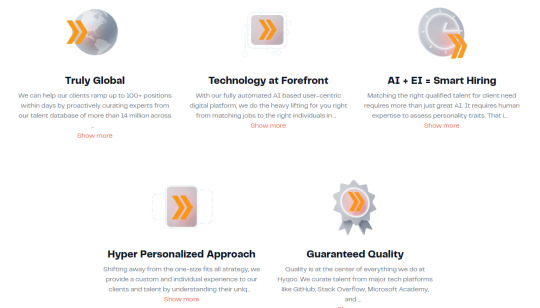
Hyqoo Helps In Hiring Remote Talent as Quickly as the Modern World Moves
We dramatically decrease the time you spend looking for talent, moving rapidly from matching the skills of prospective hires to your project’s needs to interviews and final onboarding.
Once you put in a request, the process begins.
Worked With 50% Of The Fortune 500 and Global 1000 organizations
25 years of experience managing global talent
Hyqoo talent professionals have a proven track record of shared success. For over 25 years, they have created custom-built teams of tech professionals with a specialization in enterprise clients.
A talent network of more than 14 million, with 10 million based in the U.S.
Hyqoo’s 14+ million member curated talent network covers 30+ countries and 5 continents, enabling you to ramp up to 100+ positions within days meeting demand at scale.
Hyqoo excels at deploying teams quickly with an ability to scale up rapidly. This has made us a trusted partner for prominent businesses with global reach.
Requirements Discovery
You request talent on the Hyqoo platform and the process formally begins.
Opportunity Mapping
Hyqoo talent specialists combine AI matching with real-world experience to find the best available talent to fill your role.
Team Evaluation
Hyqoo specialists review talent profiles and present them to you for evaluation.
Offer & Onboarding
Hyqoo talent specialists work with our professionals on your behalf – helping expedite interviews, finalize offers, and onboard talent for new positions.
Are you ready to find qualified talent for your team?
Hire Talent
#freelancing#freelancers#freelancer#hiring and recruitment#remote work#remoteworking#remotejob#homeoffice#smartworking#designers#developper#product manager#hiring#softwarejobs#technology
1 note
·
View note